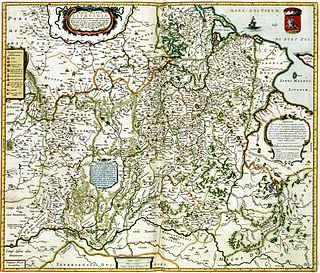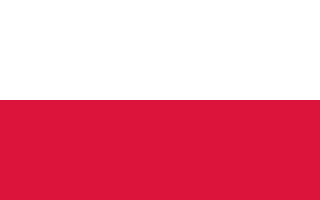Related Research Articles

The history of Lithuania dates back to settlements founded many thousands of years ago, but the first written record of the name for the country dates back to 1009 AD. Lithuanians, one of the Baltic peoples, later conquered neighboring lands and established the Grand Duchy of Lithuania in the 13th century. The Grand Duchy was a successful and lasting warrior state. It remained fiercely independent and was one of the last areas of Europe to adopt Christianity. A formidable power, it became the largest state in Europe in the 15th century through the conquest of large groups of East Slavs who resided in Ruthenia. In 1385, the Grand Duchy formed a dynastic union with Poland through the Union of Krewo. Later, the Union of Lublin (1569) created the Polish–Lithuanian Commonwealth that lasted until 1795, when the last of the Partitions of Poland erased both Lithuania and Poland from the political map. After the dissolution, Lithuanians lived under the rule of the Russian Empire until the 20th century, although there were several major rebellions, especially in 1830–1831 and 1863.

The Republic of Central Lithuania, commonly known as the Central Lithuania, and the Middle Lithuania, was a short-lived puppet republic of Poland, that existed from 1920 to 1922, without an international recognition. It was founded on 12 October 1920, after Żeligowski's Mutiny, when soldiers of the Polish Army, mainly the 1st Lithuanian–Belarusian Infantry Division under Lucjan Żeligowski, fully supported by the Polish air force, cavalry and artillery, attacked Lithuania. It was incorporated into Poland on 18 April 1922.

Eastern Borderlands or simply Borderlands was a term coined for the eastern part of the Second Polish Republic during the interwar period (1918–1939). Largely agricultural and extensively multi-ethnic, it amounted to nearly half of the territory of pre-war Poland. Historically situated in the eastern Polish–Lithuanian Commonwealth, following the 18th-century foreign partitions it was annexed by Russia and partly by the Habsburg monarchy (Galicia), and ceded to Poland in 1921 after the Peace of Riga. As a result of the post-World War II border changes, none of the lands remain in Poland today.
The city of Vilnius, now the capital of Lithuania, and its surrounding region has been under various states. The Vilnius Region has been part of the Grand Duchy of Lithuania from the Lithuanian state's founding in the late Middle Ages to 1795, i.e. five hundred years. From then, the region was occupied by the Russian Empire until 1915, when the German Empire invaded it. After 1918 and throughout the Lithuanian Wars of Independence, Vilnius was disputed between the Republic of Lithuania and the Second Polish Republic. After the city was seized by the Republic of Central Lithuania with Żeligowski's Mutiny, the city was part of Poland throughout the Interwar period. Regardless, Lithuania claimed Vilnius as its capital. During World War II, the city changed hands many times, and the German occupation resulting in the destruction of Jews in Lithuania. From 1945 to 1990, Vilnius was the Lithuanian Soviet Socialist Republic's capital. From the dissolution of the Soviet Union, Vilnius has been part of Lithuania.

Electoral Action of Poles in Lithuania – Christian Families Alliance or EAPL–CFA is a political party in Lithuania. It represents the Polish minority and positions itself as Christian-democratic. It has three seats in the Seimas, one seat in the European Parliament, and six seats in coalition with the Russian Alliance in the Vilnius City Municipality after the 2019 local election.
The issue of Polish and Lithuanian relations during World War II is a controversial one, and some modern Lithuanian and Polish historians still differ in their interpretations of the related events, many of which are related to the Lithuanian collaboration with Nazi Germany and the operations of Polish resistance organization of Armia Krajowa on territories inhabited by Lithuanians and Poles.Several common academic conferences started bridgind the gap between Lithuanian and Polish interpretations, but significant differences remain.
Jarosław Wołkonowski is a Polish-Lithuanian historian, Doctor of Philosophy with Habilitation affiliated with the University of Białystok and University of Vilnius. He is the president of Association of Polish Scientists in Lithuania.
Vilnija is a Lithuanian cultural and political organization, created to promote and cherish Lithuanian culture in Vilnius region. Due to its frequent anti-Polish bias it has been described as extremist and nationalist.

The Polish minority in Lithuania, estimated at 183,000 people in the Lithuanian census of 2021 or 6.5% of Lithuania's total population and so is the country's largest ethnic minority.
Helena Pasierbska-Wojtowicz was a Polish writer.
Lithuanization is a process of cultural assimilation, where Lithuanian culture or its language is voluntarily or forcibly adopted.

The Dubingiai massacre was a mass murder of 20–27 Lithuanian civilians in the town of Dubingiai (Dubinki) on 23 June 1944. The massacre was carried out by the 5th Brigade of Armia Krajowa (AK), a Polish resistance group, in reprisal for the Glinciszki (Glitiškės) massacre of Polish civilians committed by the Nazi-subordinated Lithuanian Auxiliary Police Battalion on 20 June 1944. The Dubingiai massacre started a wider AK operation in which units beyond the 5th Brigade were involved. In total, 70–100 Lithuanians were killed by the end of June 1944 in Dubingiai and the neighbouring villages of Joniškis, Inturkė, Bijutiškis, and Giedraičiai. While Nazi collaborators were ostensibly the prime targets, the victims also included the elderly, children, including infants of 4 and 11 months. Further conflicts between Lithuanian and Polish units were prevented by the Soviet capture of Vilnius in mid-July.
Miežionys is a village in the Vilnius district municipality, Lithuania. According to the 2011 census, its population was 92.

Lithuania–Russia relations refers to bilateral foreign relations between Lithuania and Russia. Lithuania has an embassy in Moscow and consulates in Saint Petersburg, Kaliningrad and Sovetsk. Russia has an embassy in Vilnius, with a consulate in Klaipėda, but it was closed in April 2022. The two countries share a common border through Kaliningrad Oblast.
The government of Lithuania has made provision for ethnic minorities since 1918. A substantial Jewish group that existed up to World War II was almost eliminated in the Holocaust. The Census of 2011 showed that 15.8% of inhabitants belonged to ethnic minorities: the two largest groups were the Poles and the Russians, although the proportions had decreased since independence in 1989. Other minorities include the Samogitians - not classified in the Census - and the historically important Latvian-speaking Kursenieki.
Motiejus or Matas Šumauskas was a Lithuanian communist activist and Soviet politician. He served as the chairman of the Council of Ministers from 1956 to 1963 and chairman of the presidium of the Supreme Soviet of the Lithuanian SSR from 1967 to 1975.
Jan Ciechanowicz was a Polish Lithuanian politician who was one of just several ethnic Polish members of the Supreme Soviet of the USSR (1989–1991).

The Polish National Territorial Region was a proposed autonomous region in Lithuania, unilaterally proclaimed by the local Polish-Lithuanian politicians on 6 September 1990. The proposed region should have included the districts of Vilnius, Šalčininkai and adjacent parts of some other districts — where Poles formed the majority of the population. This Eastern part of Lithuania had been part of Poland during the Interwar period before being attached to Lithuania under the Mutual Assistance Treaty with the Soviet Union in 1939. The proposed capital of the region was Nowa Wilejka which had 34% Polish population. with an area of 4,930 km2 (1,900 sq mi) and population of 215,000. In the region, the Polish flag was to be used as the official flag and Rota was to be used as an anthem in the region.

The Soviet economic blockade of Lithuania was imposed by the Soviet Union on Lithuania between 18 April and 2 July 1990.
East Polish Soviet Socialist Republic, abbreviated to East Polish SSR, also known as the Republic of Eastern Poland, was a proposition to establish a constituent republic of the Soviet Union, from the part of the territory of Lithuanian SSR and Byelorussian SSR. Its territory was planned to include the area with the majority of Polish population, including the Vilnius Region and area around the city of Grodno. The idea emerged in early 1990, during the dissolution of the Soviet Union.
References
- ↑ Od izolacji do współpracy, Gazeta Wyborcza z 30 grudnia 1994
- ↑ Tadeusz Dąbrowski, Kwestia polska w ostatnich latach istnienia ZSRR, w: "Rocznik Wschodni", Rzeszów 1995
- ↑ Po szkodzie to samo, Gazeta Wyborcza z 22 listopada 1994
- ↑ Ryszard Maciejkianiec, Rozwarty wachlarz czy krótka pałka? Archived 2016-02-07 at the Wayback Machine , "Nasz Czas", nr 1 (651), 2005